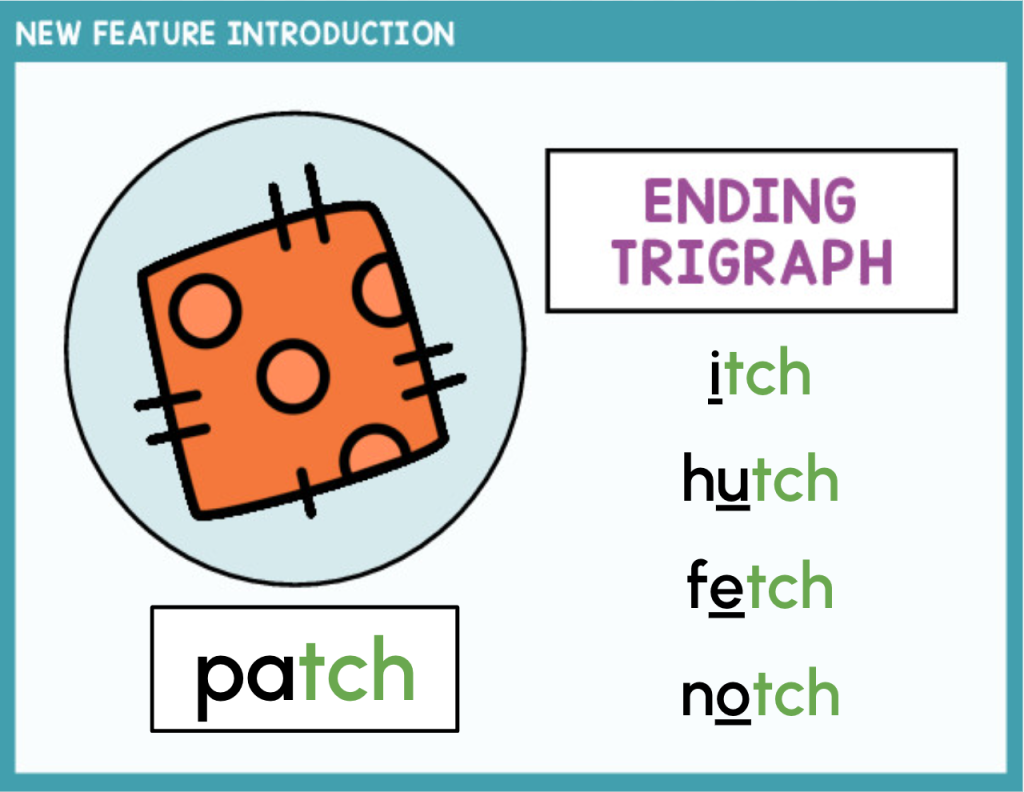Trigraph: 3 letters that stand for one phoneme (e.g. tch, dge)
- -tch = /ch/ after short vowel (e.g. catch)
- -dge = /j/ after short vowel (e.g. ridge)
After I finished creating Literacy Lessons Level 2, which covered consonant blends, I noticed that several of my students needed to work on reading and spelling words with the trigraphs -tch and -dge.
Most phonics programs do not teach these features until much later in the sequence, but I figured that it would be appropriate to teach them right after blends and before teaching long vowels since these two features are only found within words directly after short vowels.
I decided to add lesson slides and practice packets for both features and have added them to the Literacy Lessons: Level 2 Bundle on TPT in case you are interested in checking them out!
-TCH: LESSON 1
To introduce the concept, I have my students listen to a set of words and tell me whether or not they hear the sound /ch/ at the end of each word. I use the slide below to guide this activity and my students love to see their responses confirmed with a check or x as I click through.
After making sure that students can isolate and identify the sound, I move to the next slide for explicit teaching of the new feature with a key word and some example words that students might already be familiar with.

Next, we practice blending real and nonsense words that contain the new feature. The grapheme cards pop up one at a time, which really helps my students who struggle with blending. It allows them to focus on blending the first two sounds together and then adding the remaining sounds on as the other cards pop up. For students who have already mastered blending, I tend to click through these at a much faster pace.
After that I show them pictures of words that contain the feature and have them segment the sounds before telling me which letter(s) represent the sounds needed to spell the word. I think that this part helps to reinforce the fact that they need to slow down and segment carefully in order to spell words correctly and the visuals are helpful for introducing new vocabulary.
Finally, I give my students whiteboards and dry erase markers and have them practice spelling a list of words that contain the feature. (The word lists for each lesson are included in the Speaker Notes on the Dictated Spelling slides, so I don’t need anything other than my slides to teach this entire lesson).
-TCH: LESSON 2
In the second lesson, after reviewing the sounds that students have already learned, we do a word sort. I remind students of the spelling rule (in this case: use -tch after a short vowel and -ch after a consonant) and then present students with a set of images/words for them to segment, isolate the sound before /ch/, and determine which spelling would be used.
After that, they do some more blending practice with real and nonsense words and then I introduce High-Frequency Words that contain the featured grapheme using the Heart Word method. Then we review all of the HFWs that they have already learned before another round of dictated spelling.
-TCH: LESSON 3
In the final lesson, we review all graphemes/sounds to warm up and then students complete a phonemic awareness word chaining activity in which I give them a word and ask them to change a sound to come up with the next word in the chain.
Next, we do some more blending and review High-Frequency words before the Word-Meaning Connection portion of the lesson. In this part of the lesson, students learn the meaning of vocabulary that contains the feature. They also learn about homophones, words with more than one meaning, verb tenses, and common phrases/idioms that contain words with the featured grapheme.
In addition to the slides, I give students the -TCH: Printable Packet so they can continue to practice applying the new concept. Sometimes I will have students work on these packets while I do progress monitoring with others in their group or, if we don’t have time to complete the practice sheets during group time, I will send them home for “homework” and for families to see what we are working on.
The lesson and packet for the trigraph -DGE are pretty much identical to this lesson and packet, so I won’t share all the details here, but you can find out more in the product description in my TPT store.
If you are interested in checking out these resources for the Trigraph -TCH or the trigraph -DGE, the links below will take you to the individual products:
